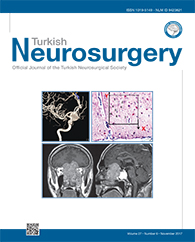2Medipol University, School of Medicine, Department of Neurosurgery, Istanbul, Turkey
3Süleyman Demirel University, Department of Neurosurgery, Isparta, Turkey
4Gulhane Military Medical Academy, Department of Neurosurgery, Ankara, Turkey
5Akdeniz University, School of Medicine, Department of Histology and Embryology, Antalya, Turkey DOI : 10.5137/1019-5149.JTN.17871-16.1 AIM: To investigate the anti-scarring potential of topical cyclosporine on rat sciatic nerves.
MATERIAL and METHODS: Both sciatic nerves were exposed in 24 adult male albino Wistar rats, and an abrasion injury was made on the biceps femoris close to the sciatic nerve. Cotton pads soaked with cyclosporine (5 mg/mL) and saline (0.9% NaCl) were placed around the nerves for 10 minutes in the experimental group and control group, respectively. All rats were sacrificed 8 weeks later and the sciatic nerves were examined. Epineurial adhesions were assessed using light and electron microscopy. Quantitative histological parameters, epineurial thickness, and scar density were evaluated in the histological investigation.
RESULTS: Significantly fewer epineurial adhesions were observed in the cyclosporine group in the post-surgical assessment, and the histopathological and ultrastructural examinations of the nerve segments than in the controls. The cyclosporine-treated animals had a statistically significant reduction in the density and quantity of epineurial scarring compared with the controls.
CONCLUSION: Topical cyclosporine effectively reduces epineurial scar formation on rat sciatic nerves.
Keywords : Cyclosporine, Sciatic nerve, Epineurial fibrosis, Rat




